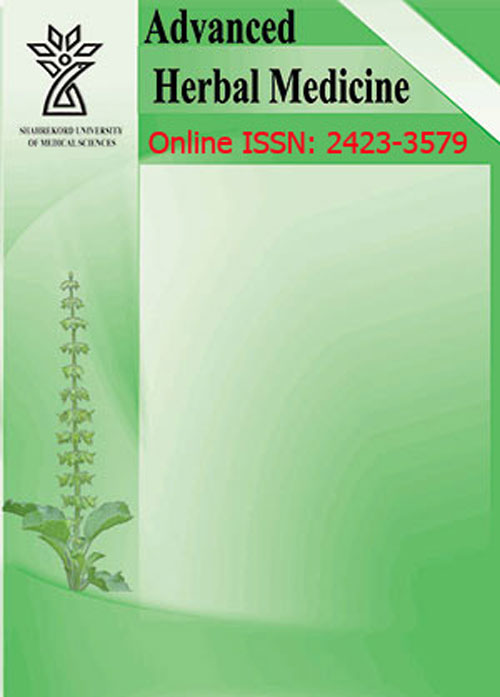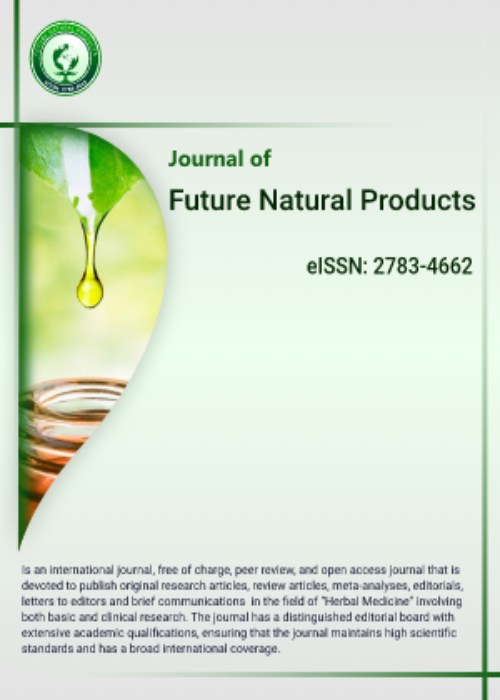فهرست مطالب

Future Natural Products
Volume:4 Issue: 1, Winter 2018
- تاریخ انتشار: 1396/11/30
- تعداد عناوین: 8
-
Pages 1-2According to Avicenna, tooth decay occurs as a result of the moisture permeation caused by rise of stomach contents or the sinus secretions draining from the retropharyngeal space into the mouth. He asserts that the stomach health and accordingly proper food digestion play a very important role in dental health.According to Avicenna, tooth decay occurs as a result of the moisture permeation caused by rise of stomach contents or the sinus secretions draining from the retropharyngeal space into the mouth. He asserts that the stomach health and accordingly proper food digestion play a very important role in dental health.According to Avicenna, tooth decay occurs as a result of the moisture permeation caused by rise of stomach contents or the sinus secretions draining from the retropharyngeal space into the mouth. He asserts that the stomach health and accordingly proper food digestion play a very important role in dental health.According to Avicenna, tooth decay occurs as a result of the moisture permeation caused by rise of stomach contents or the sinus secretions draining from the retropharyngeal space into the mouth. He asserts that the stomach health and accordingly proper food digestion play a very important role in dental health.Keywords: Dental Erosion, Gastroesophageal Reflux, Avicenna
-
Pages 3-13Background and aimsTooth decay is one of the most common chronic diseases around the world and this problem is the result of variety of different bacteria. Streptococcus mutants is one of the most important bacteria which is related to this disease. Finding new effective antibacterial agents is an important area in bioscience for fighting and controlling bacterial infections. Essential oils are most important natural sources of antibacterial agents, particularly against drug-resistant bacteria.MethodsThe aim of this study was to evaluate and compare the antibacterial activity of three essential oils Mentha arvensis, Mentha piperita and Foeniculum vulgare Mill against Streptococcus mutants. Disk diffusion method was carried out and the minimum inhibitory concentration (MIC) and minimum bactericidal concentration (MBC) were measured.ResultsThe results showed that all three essential oils have antibacterial activity against S. mutants. With a constant concentration of 100 µg/µl, the efficiency of Mentha piperita and then Foeniculum vulgare Mill was higher than the efficiency of Mentha arvensis at all 3 given time points (24, 48 and 72 hours). The most effective MIC and MBC were related to Streptococcus mutants using Foeniculum vulgare essential oil which were equal to 8.4 and 14.9 µg/ml, respectively. MIC and MBC for Mentha piperita essential oil were measured 10.5 and 16.3 µg/ml, respectively.ConclusionThe Essential oils used in present study with different components showed antibacterial activity and therefore they can be used as new antibacterial substances.Keywords: Chronic disease, Infection, essential oil, Disk diffusion
-
Pages 14-22Background and aimsDiabetes is a metabolic disorder associated with diseases. The use of supplements, herbal extracts, and exercise training for the treatment of diseases and metabolic disorders has increased among people. Thus, the aim of this study was to investigate the effect of 10-week aerobic training with and without ginger supplementation on aerobic power, BFP, and insulin resistance in obese middle-aged women with type 2 diabetes.MethodsIn this study, 46 obese diabetic women (BMI > 30, blood fasting sugar more than 150-250 mg/dL, 45-60 years old) were selected and randomly assigned into four groups, ginger (n=12), aerobic exercise training + ginger (n=12), aerobic exercise training (n=12) and control (n=10). Participants in supplementary groups received four 250 mg capsules ginger extract 1000 mg daily for 10 weeks. Aerobic training program included 10 weeks of training, 3 sessions per week and each session was 60 minutes at 55% maximum heart rate during the first week and gradually increased with the progress of the training program to 75 percent of maximum heart rate.ResultsAfter 10 weeks, significant difference was observed in weight, BMI, body composition, VO2max, Insulin, fasting glucose and insulin resistance (P<0.05). In the within group changes was observed significant decrease in insulin levels and insulin resistance was in the aerobic exercise training + ginger group (P<0.05).ConclusionAccording to obtained results, it appears that aerobic training plus ginger extract consumption have better effect on insulin levels and insulin resistance in obese middle-aged women with type 2 diabetes.Keywords: Aerobic training_Ginger_type 2 diabetes
-
Pages 23-30Background and aimsZataria multiflora Boiss (ZM) is a thyme-like plant reported to have immunomodulatory properties. This study was aimed to examine effects of ZM essential oil on performance, biochemical and immunological parameters in broilers.MethodsTwo hundred and forty, broiler chickens were divided into 4 groups. CON considered as control group received basal diet, T100, T200 and T400 treated by basal diet supplemented with ZM 100, 200 and 400 mg/kg feed, respectively. Body weight and feed intake were recorded at 14, 28, and 42 days of age. At the end of experiment, eight broilers per group were slaughtered and carcass portion yield was calculated. Humoral immune response efficacy by injection of 5% sheep red blood cell into the pectoral muscle of birds was evaluated.ResultsThis study showed that supplementation of ZM promoted the weight gain in T200 as compared to other groups (P<0.05). Also, the best food conversion ratio was achieved in the same group. On the other hand, ZM supplementation in all of the doses used, did not cause significant increase in carcass portion yield (P<0.05), except for liver weight, which was significantly increased in T400. Serum biochemical analysis showed that levels of total protein, albumin and globulin were highest in T200 while the lowest were in T400; addition of ZM especially at the dose of 200 mg/kg improved immune responses in broilers (P<0.05).ConclusionAccording to the results of present study, supplementing broilers diet with ZM could have favorable impact on performance and immunity.Keywords: Zataria multiflora, Growth performance, Serum Biochemical Parameters, Immunity, Broilers
-
Pages 31-39Background and aims
PCOS (polycystic ovary syndrome) is the most common endocrine and metabolic disorder characterized by amenorrhea, hyper androgens, hirsutism, chronic anovulation and infertility. The aim of the present study was determining the effects of ginger extract, and 6-gingerol on hormonal levels and ovarian follicles in induced PCOS rats, and comparing the ameliorating effects of these two substances for treatment of PCOS.
MethodsIn this experimental research, 42 adult female Wistar rats weighting between 160 g-180 g were divided into six groups of 7 animals. PCOS control that received no injection. PCOS received intraperitoneal injections of 100 mg/kg of ginger extract (for 28 days). Statistical analyses with SPSS, one-way ANOVA, T-test and Duncan test wereused to compare groups.
ResultsIn comparison with PCOS control, the treatment of PCOS rats with ginger extract (100 and 200 mg/kg) and 6-gingerol (200 and 400 µg/kg) led to significant decrease in LH levels. There was a decrease in FSH levels, but the significant one was only in the 6-gingerol treated group (400 µg/kg). In PCOS treated groups with gingerextract and 6-gingerol, the serum levels of estradiol decreased significantly compared to control and PCOS control groups (P<0.001). Progesterone levels in PCOS groups injected with ginger extract and 6-gingerol showed a significant increase (P<0.05). In PCOS treated groups with ginger extract and 6-gingerol, testosterone levels decreasedsignificantly (P<0.001, P<0.01, P<0.05).
Conclusion6-gingerol and ginger extract may be a useful treatment for improving the PCOS through reduction of estrogen, testosterone, LH and FSH, and improvement of ovulation. In fact, because of anti-inflammatory and antioxidant properties of ginger components, especially 6-gingerol, they can cause to improve PCOS
Keywords: Ginger, 6- gingerol, PCOS, Estradiol valerate, rat -
Pages 40-46Background and aims
Visceral leishmaniasis so called Kala-azar is one of the important health care problems in the world. Some herbal drugs are noticed because of toxicity and drug resistance against pentavalent antimonials as used in treatment of Kala-azar. In this study, anti-leishmanial activity of Pelargonium roseum Essential oil on the in vitro growth of Leishmania infantum promastigotes in comparison to Glucantime was studied.
MethodsDifferent concentrations of Pelargonium roseum essential oil on culture of Leishmania infantum promastigote were surveyed with Anti-leishmania activity assays at 24 hr and 48 hr at 570 nm wavelength. All the data were analyzed by using SPSS version and anti-leishmanial potency of the oil extract of Geranium in different concentration were compared with standard dose of Glucantime.
ResultsAll concentration in 24 hr showed no remarkable difference. 25, 50 and 100 µL/ml efficacy was same as Glucantime on the growth of promastigotes in 24 hr MTT. All concentrations except 1µL/ml in 48hr MTT had resemble impact on the growth of promastigotes. 5 µL/ml concentration of Pelargonium roseum essential oil was significant difference effect on the parasite (P= 0.043) in 48hr.
ConclusionPelargonium roseum essential oil doesn’t treat Leishmania infantum promastigote quickly. After 48 hr, 5 µL/ml concentration can be a suitable candidate in clinical trials.
Keywords: Leishmania infantum, Pelargonium roseum, promastigote, Glucantime -
Pages 47-57Background and aims
Herbal medicines has been a major remedy in traditional medical systems from thousands of years and made a great contribution in maintaining human health and in preventing many infectious diseases. K. pneumonia is a bacterial negative intestinal bacillus and a member of Enterobacteriaceae family. This paper aims at investigating the antimicrobial effects of the methanol extract of wind cheese prepared by ultrasonic waves on the K. pneumonia
MethodsAll 12 isolates of K. pneumoniae isolated from urine culture of hospitalized patients (Amir al-Mu'minin Hospital, Zabol, southeastern of Iran) suffered from urinary tract infection during the years 2013 and 2014. In this study, the extract of W. somnifera obtained by ultrasonic waves. Then the minimum inhibitory concentrations and minimum bactericidal concentration were investigated to characterize the antibacterial activities of this extract
ResultThe result showing that plant extracts from W. somnifera had inhibitory effect against K. pneumoniae. The MIC values were also determined against all the tested bacteria. The highest MIC values of extract were found to be 5mg/ml against K. pneumoniae and four of MIC value for K. pneumoniae was 2.5 mg/ml. (p<0.005).
ConclusionThe obtained results showed that extraction by using ultrasonic method improved the efficiency and amount of the antimicrobial effects of the plant. So, ultrasonic waves can be used as a stimulus for increasing the antimicrobial effects of the plant.
Keywords: Antimicrobial effects, Withania somnifera, Ultrasonic waves, Antimicrobial activity -
Pages 58-70Background and aims
One of the most important world wide zoonotic infection is dermatophytosis which caused by dermatophytes fungi. Dermatophytosis treatment minimizing the time course of the infection and the potential of spread to other animals and humans. The aim of this study is to use the Artemisia sieberi nano-essence to treat dermatophytosis caused by Microsporum canis under experimental conditions in guinea pigs.
MethodsIn this study guinea pigs randomly divided to 7 groups; negative control, positive control, terbinafine hydrochloride 1% and 4 different nano-essence concentrations treatment. 5 day after Microsporum canis suspension inoculation to abraded skin, treatment program for every nano-essence dilutions and terbinafine was started every 12 hours for 40 days.
ResultsComparison of all nano-essence and terbinafine treatment groups on various days till 4oth day revealed no significant differences. Three consecutive culture results for all animals was negative on days 33, 40 and 50 in nano-essence groups but 16% of terbinafine groups was positive in fungi culture on day 33.
ConclusionsThe results showed the nano-essence treatment groups showed improved clinical symptoms faster than the terbinafine treatment group over a shorter treatment period.
Keywords: Guinea pig, Terbinafine, Artemisia sieberi, Microsporum canis, Nano-essence


